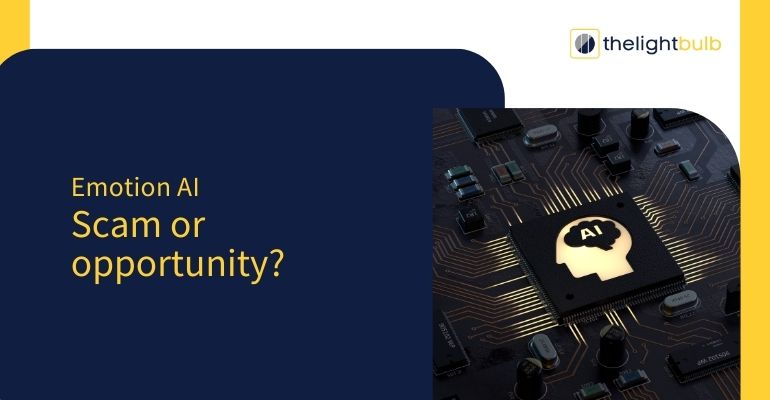
The Role of Facial Action Coding System in Improving Qualitative Research Outcomes
Qualitative research is the foundational concept behind analyzing and logically evaluating human behavior, motivations, and emotions. While the conventional humanitarian modes of qualitative research like interviews and focus groups are invaluable, they have a major drawback of heavily relying on self-reported data, as a result, it sometimes leads to missing the nuances of genuine human emotion.

This is when the Facial Action Coding System (FACS) comes into action, revolutionizing the entire game of doing qualitative research. The concept allows researchers to dig and dive deeper into the emotional underpinnings of participant responses.
Through this blog post, we’ll explore and share the role of FACS in transforming the qualitative research process, making it substantially efficient compared to traditional methods. We’ll also share an innovative solution – TheLightbulb’s Insights Pro for Qualitative Research to leverage concepts the emotion AI and FACS for generating data-rich insights.
What is FACS and How Does it Work?
The Facial Action Coding System refers to the scientific method of mathematically analyzing emotions through the facial expressions of the participants. The concept was first developed by psychologist Paul Ekman. In his approach, he breaks down the facial expressions into Action Units (AUs), which are nothing but specific muscle movements that are the direct outcome of universal emotions, representing happiness, sadness, anger, and surprise.
With the rise of AI, facial coding now integrates computer vision and machine learning, making it faster and more accurate. These tools analyze micro-expressions—subtle, involuntary facial movements—to reveal hidden emotional responses that may not be consciously expressed or reported by participants.

With the rise of AI, facial coding can now effortlessly integrate computer vision with machine learning, making it faster and more accurate. Tools have been
Imagine showing a product prototype to participants in a focus group. While someone might verbally express mild approval, facial coding could detect a fleeting frown, indicating hesitation or disapproval. Such insights are invaluable for shaping decisions based on authentic emotional feedback.
How FACS Enhances Qualitative Research
Here’s how the Facial Action Coding System enhances the qualitative process, making it more efficient and robust –
1. Accurate Emotional Insights
Facial coding accurately mitigates the limitations that the traditional approach of taking interviews or focus groups. Now, with FACS, one can easily capture subconscious expressions that are unlike true feelings that might not be articulated due to factors social desirability bias, cultural norms, or personal inhibitions in the participant environment.
2. Data-Driven Decision Making
FACS effortlessly captures qualitative data and churns out quantifiable insights in real time. For instance, with Facial Action Coding marketers can evaluate the unique elements of an advertisement campaign to make it resonate with the true emotions of target customers. Thereby, fine-tuning the campaigns to maximize engagement and impact.
3. Improved Contextual Analysis
What makes qualitative research highly meaningful is closely understanding and consuming the context of emotions. FACS allows researchers to link specific stimuli—such as an ad, product design, or question—to emotional responses, providing actionable insights tailored to participant reactions.
Why Emotion Coding Matters in Qualitative Research
Within the Emotional Analysis Framework, Emotional Coding is observed as a systematic approach for categorizing participant emotions during the qualitative research process. This approach bridges the gap between the limitations of traditional approaches like surface-level feedback and deeper, subconscious true emotions, enriching data interpretation.
Today, researchers integrate emotion coding to capture the holistic understanding of participant experiences as a result, raising the curtains from the hidden wealth of true emotions.

For example, emotion coding in a focus can highlight triggers for expressions of satisfaction and dissatisfaction for exploring customer loyalty. Thus, enabling businesses to enhance their offerings effectively.
The best part, the process for implementing this technology is quite straightforward, let’s check them out –
Key Benefits of Facial Coding in Research
Here are some of the key benefits that research scientists often reap while performing their qualitative research –
1. Unlock Unstated Responses
FACS collects unconventional emotional nuances, something that prospects would not even verbally express. This activity is quite crucial for culturing diverse groups.
2. Enhances Participant Engagement
By focusing on emotional cues, researchers can adapt their approach in real time. For example, during a live interview, facial coding might indicate boredom or confusion, signaling the interviewer to adjust their questioning style.
3. Reduces Bias in Data
Traditional methods often suffer from biases inherent in self-reported data. FACS objectively decodes facial expressions, reducing reliance on subjective interpretations and offering a more balanced view of participant responses.
4. Accelerates Research Turnaround
With AI-powered tools like TheLightbulb.ai’s Insights Pro, facial coding reduces the time needed for data collection and analysis. Insights can be generated in days rather than weeks, enabling businesses to act swiftly on findings.
How TheLightbulb.ai’s Insights Pro Empowers Researchers with FACS
TheLightbulb.ai’s Insights Pro is an innovative tool that combine facial action coding with other technologies like speech transcription and text sentiment analysis under the umbrella of Emotion AI technology.

Must Read: Can Facial Emotion Coding & Speech Sentiment Analysis help with Consumer Insights?
Here’s how Insights Pro simplifies the entire qualitative research process –
- Emotion Detection: Detect engagement levels and emotional shifts during live focus groups or one-on-one interviews.
- Speech Transcription: Automatically transcribe conversations, reducing administrative tasks and allowing researchers to focus on insights.
- Text Sentiment Analysis: Analyze transcribed speech to uncover hidden preferences or dislikes.
- Audio Tonality Analysis: Examine vocal cues—like pitch and intonation—for additional emotional context.
- Custom Reports and Dashboards: Access detailed insights at both session and participant levels, making it easier to identify trends and patterns.
This comprehensive approach ensures that no emotional detail is missed, providing researchers with a rich tapestry of data to inform their decisions.
Conclusion: Transform Your Research with FACS and Insights Pro
With the evolution of AI, understanding the true human emotions of your customers has become pivotal in decision-making tasks such as qualitative research. Facial Action Coding System offers a game-changing opportunity for qualitative researchers. By evaluating the micro-expressions researchers are able to gain insights that couldn’t been possible with surface level emotions, helping in uncover deeper truths.
Innovative platforms like TheLightbulb.ai’s Insights Pro for Qualitative Research harnesses the power of FACS, emotion AI, and advanced analytics to deliver actionable, emotion-rich insights. Whether you’re testing a product, evaluating a campaign, or exploring customer experiences, Insights Pro empowers you to make data-driven decisions with confidence.
Want a demo? Contact the team.











